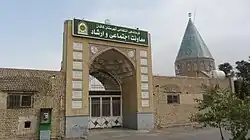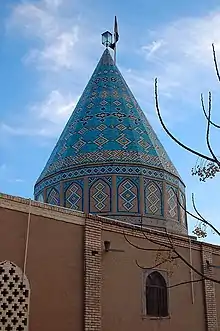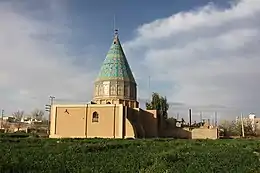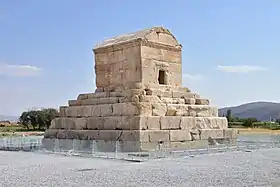| Shrine of Abu Lu'lu'a | |
|---|---|
 | |
 Location within Iran | |
| General information | |
| Status | intact closed since 2007[1] |
| Type | mausoleum |
| Architectural style | Mongol, Safavid[2] |
| Location | Kashan |
| Country | |
| Coordinates | 33°58′11.0″N 51°24′59.5″E / 33.969722°N 51.416528°E |
| Named for | Abu Lu'lu'a Firuz (d. 644) |
| Completed | c. 13th–15th century[2] |
| Known for | purported resting place of the assassin of Umar ibn al-Khattab |
The Shrine of Abu Lu'lu'a (Persian: بقعه ابولولو), also known as the Shrine of Bābā Shujāʿ al-Dīn (بقعه بابا شجاع الدين)[2] is a mausoleum built over what is popularly believed to be the final resting place of Abu Lu'lu'a Firuz, a Persian slave who assassinated the second Islamic caliph Umar ibn al-Khattab in 644.[3]
The structure dates back to the Mongol era,[2] and is located in Kashan (Isfahan Province, Iran).[4] The building was closed in 2007 by the Iranian government, due to pressure from the International Union of Muslim Scholars.[1]
Building

The original structure was built before the Safavid period (1501–1736), at some time during the Mongol era (13th–15th century).[2] The tombstone bears the date 777 AH (1375 CE).[5] However, the building's dome and iwan date from the Safavid period or later.[2]
The tombstone, which is not present in the shrine today but has been documented in the 20th century, does not mention Abu Lu'lu'a or any other name. It reads:[5]
This is the grave of a slave from the pious worshippers of Allah. May Allah (swt) gather him with those who he loved – year 777 hijri.
From the 16th or 17th century onward Abu Lu'lu'a became known as Bābā Shujāʿ al-Dīn (lit. 'Father Courageous of the Faith'), a nickname which he received in connection to the annual celebrations that were starting to be held in his honor at the shrine in Kashan.[6] According to one theory, the person entombed in the shrine in Kashan is not Abu Lu'lu'a, but an otherwise unknown Sufi known as Bābā Shujāʿ al-Dīn. The word "Bābā" is a title used for high ranking Sufi masters in Persia.[7]
Festival

The historical Abu Lu'lu'a died in Medina (the capital of the early caliphate, situated in the Arabian Peninsula) shortly after his assassination of Umar in 644 CE.[8] Later legends arose according to which Abu Lu'lu'a was saved from his pursuers by Ali ibn Abi Talib (the cousin and son-in-law of the Islamic prophet Muhammad, who is also revered by Shi'ite Muslims as the first Imam). These stories say that Ali instantaneously transported Abu Lu'lu'a by means of a special prayer to Kashan, where he married and lived out the rest of his life.[9]
During the 16th-century Safavid conversion of Iran to Shia Islam, a festival started to be celebrated in honor of Abu Lu'lu'a, commemorating his assassination of Umar ibn al-Khattab.[10] Named Omar Koshan (lit. 'the killing of Umar'), it was originally held around Abu Lu'lu'a's sanctuary in Kashan, each year at the anniversary of Umar's death (26 Dhu al-Hijja of the Islamic year).[11] Later it also started to be celebrated elsewhere in Iran, sometimes on 9 Rabi' al-Awwal rather than on 26 Dhu al-Hijja.[12] The festival celebrated Abu Lu'lu'a, nicknamed for the occasion Bābā Shujāʿ al-Dīn (lit. 'Father Courageous of the Faith'), as a national hero who had defended the religion by killing the oppressive caliph.[13]
Due to political sensitivities, from the Qajar period (1789–1925) onward the festival gradually stopped being celebrated in the major cities of Iran, until it was eventually banned officially by the Islamic Republic of Iran in 1979.[14] Nevertheless, the festival itself is still celebrated in Iran, though often secretly and indoors rather than outdoors.[15] It is now held on the 9th day of the month of Rabi' Al-Awwal of the Islamic year, lasting until the 27th of the same month.[16]
Controversy

In recent years, controversy was caused when al-Azhar University demanded the Iranian government demolish Abu Lu'lu'a's shrine because the shrine was considered to be "offensive and un-Islamic" by mainstream Sunni scholars. The issue caused the cancellation of diplomatic relations between the university and the Iranian government.[17] Due to this Sunni pressure, which also included an intervention by the International Union for Muslim Scholars, the Iranian government shut down the shrine in 2007.[1]
See also
References
- 1 2 3 Isma'il 2007, referred to by Ismail 2016, p. 93; Ali 2018.
- 1 2 3 4 5 6 Anonymous 1975. Quote: "اصل بنا احتمالا مربوط به دوران قبل از صفويه وبقول به دوران مغول ميرسد ولى گنبد وايوان آن ازبناهاى دوران صفويه ودورانهاى بعد مياشد.".
- ↑ On Abu Lu'lu'a, see Pellat 2011.
- ↑ Algar 1990.
- 1 2 Ali 2018, citing Āthār Tārīkhī Shehr-hāye Kashān wa Naṭanz, p. 186 and Muḥammad Bāqir Marandī, Nūr Bāhir, p. 14, who visited the tombstone in 1381 AH (= 1961–2 CE).
- ↑ Johnson 1994, p. 127, note 23; Calmard 1996, p. 161.
- ↑ Ali 2018.
- ↑ Pellat 2011.
- ↑ Fischer 1980, p. 16; Johnson 1994, p. 127, note 23. According to Ali 2018, the earliest version of the transportation story as related by Imād al-Dīn Ṭabarī in his Kāmil-e Bahāī (675 AH = 1276–7 CE) mentioned a mystical transportation to Qom, but later the story was changed to Abu Lu'lu'a's being transported to Kashan instead, possibly to authenticate the presence of the mausoleum in Kashan.
- ↑ Algar 1990; Torab 2007, p. 196.
- ↑ Johnson 1994, p. 127, note 23; cf. Algar 1990.
- ↑ Calmard 1996, p. 161; Algar 1990.
- ↑ Calmard 1996, p. 161; Johnson 1994, p. 127, note 23; Torab 2007, p. 196.
- ↑ Algar 1990; Torab 2007, pp. 194–195.
- ↑ Torab 2007, p. 195.
- ↑ Torab 2007, p. 198.
- ↑ Ismail 2016, p. 93.
Sources cited
- Algar, Hamid (1990). "Caliphs and the Caliphate, as viewed by the Shiʿites of Persia". In Yarshater, Ehsan (ed.). Encyclopædia Iranica, Volume IV/7: Calendars II–Cappadocia. London and New York: Routledge & Kegan Paul. pp. 677–679. ISBN 978-0-71009-130-7.
- Ali, Sayyid (12 November 2018). "Is Abu Lulu Buried in Kashan?". Iqra Online.
- Anonymous (6 September 1975) [15 Shahrivar 1354 SH]. "بقعه ابولولو / ۱۰۹۱" (PDF). دانشنامهی تاریخ معماری و شهرسازی ایران [Encyclopaedia of the History of Architecture and Urban Planning of Iran]. Registration no. 1091 (in Persian). Ministry of Roads and Urban Development.
- Calmard, Jean (1996). "Shi'i Rituals and Power II. The Consolidation of Safavid Shi'ism: Folklore and Popular Religion". In Melville, Charles (ed.). Safavid Persia: The History and Politics of an Islamic Society. Pembroke Persian Papers. Vol. 4. London: I.B. Tauris. pp. 139–190. ISBN 1-86064-023-0.
- Fischer, Michael M. J. (1980). Iran: From Religious Dispute to Revolution. Cambridge, MA: Harvard University Press. ISBN 9780674466159.
- Isma'il, Faraj (13 June 2007). "بعد تدخل الاتحاد العالمي لعلماء المسلمين : السلطات الإيرانية تغلق مزار "أبو لؤلؤة المجوسي" قاتل عمر بن الخطاب". Al Arabiya. Archived from the original on 15 June 2007.
{{cite web}}: CS1 maint: unfit URL (link) - Ismail, Raihan (2016). Saudi clerics and Shī'a Islam. New York: Oxford University Press. ISBN 9780190627508.
- Johnson, Rosemary Stanfield (1994). "Sunni Survival in Safavid Iran: Anti‐Sunni Activities During the Reign of Tahmasp I". Iranian Studies. 27 (1–4): 123–133.
- Pellat, Charles (2011). "Abū Loʾloʾa". In Yarshater, Ehsan (ed.). Encyclopaedia Iranica.
- Torab, Azam (2007). Performing Islam: Gender and Ritual in Iran. Leiden: Brill. doi:10.1163/9789047410546_009.

